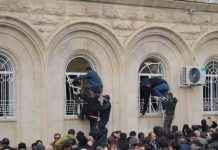The building density is also detrimental to the house Sparrow – he finds hardly any place in the city. A protection program to secure the habitat of the sparrows now.
Thomas calls
The sparrows seem to have fun. Of a Branch, they hop to the next, sometimes up, sometimes down. The dance of the small bloated birds in the bare Bush seems arbitrary, but who is watching the Goings-on longer, you can almost make a Choreography. Suddenly, a male from the ranks of swerves, bounces on the ground forward, looks around, jumps up to a couple of sunflower seeds. But instead of keeping his prey to himself, chirps the Sparrow to his brethren in the Bush, that he has discovered food. “Sparrows are very sociable,” says Sylvia Weber. The sparrows an expert from the country Confederation for the protection of birds (LBV) is in Munich next to the bushes in front of the entrance to Perlacher Mall and Pep has brought the birds grains. Weber has here in the South-East of Munich, between the Pep and the Parking lot, between the site and the main transport hub with a Mission: she wants to preserve the habitat of the Perlacher Sparrow colony.
A few meters above the Sparrow Bush hanging every couple of meters nest boxes, which has made the Pep in consultation with the TCA there. The House sparrows to take the new accommodation already. The residential project is located on the other side of the Thomas-Dehler-Straße, in the middle of the construction site for the future “culture square”, a large residential and cultural center. Behind the Fences, a dark tower in the blue winter sky looms above a bird floating houses, in which there are up to 60 breeding courses on three floors.
Sylvia Weber the sparrows expert from the land Covenant is for the protection of birds.
(photo: Stephan hull)
A few yards more a giant rusty ball, which at first looks like a pile of junk from the construction site is located. But this is the “date of Deposit III”, a huge sculpture made of iron mesh of the artist Adrian Marynak, the middle of September, from the now demolished house of culture at the Hanns-Seidel-Platz with a crane was umgehoben. The massive Nest of metal had become in the past few years, in fact, to the shelter for a whole Sparrow colony. Without the bail-out of the work of art and the construction of the Sparrow tower, the birds were gone, probably from the PEP Lacher center, the colony would be destroyed.
But why all that effort for a supposed all over the world to bird like the house Sparrow? “The birds, the culture-follower par excellence, the house Sparrow has connected many thousands of years ago the people,” says Weber. Passer domesticus, as Sparrow, or house Sparrow, as with the Latin name, lives in cities, almost exclusively in crevices and cavities of buildings. However, with the ever denser development, especially in a city like Munich, where meadows, hedges and bushes will disappear and old buildings, increasingly, new buildings with hermetically sealed roofs and facades, soft, sparrows is less and less place to live.
a few decades ago, the trusting birds were ubiquitous in beer gardens, and squares, green areas and industrial wastelands. However, the Population in Munich goes back for years. In the meantime, the birds live only a few corners in the downtown area in small populations. Already in the spring of 2017, the SPD had demanded group in the city Council in a request to provide the sparrows in Munich, more protection – with sparrows towers and lawns around.
Since then, a lot has happened. Meanwhile, place Jean-Paul-Richter-Straße in Sendling-Westpark and St Peter’s were drawn up with the help of the TCA four sparrows towers, and partly on private land, such as on the Hanns-Seidel-Different-road in the new development area in Pasing, but there is also a tower behind the Playground of the elementary school at the Gertrud-Bäumer-road in Neuhausen. Wherever sparrows have now moved in. In December, the city Council adopted a package of measures in order to protect Sparrow populations better in the future. Part of this is that now is can be created, tested, in which schools in Munich nesting sites for House sparrows, also other locations are to be found.
can It be, what are the schools in Munich nesting sites for House sparrows created is checked.
(photo: Stephan hull)
The TCAS have in mind, for example, the Petuelpark. There is in an old building opposite the cafe Ludwig, is a large Sparrow colony. The Bird advocates fear that the house will be demolished, which could mean the end of the flock of Birds above the lid of the Middle ring. Because the destruction of the habitat can be for Sparrow colonies fatal. They do not fly long distances, your daily flight radius is usually between 50 and 200 meters. They are therefore very loyal to their location. If a colony in one place, such as in the steel ball of Neuperlach has settled, it remains there. As soon as the end of February, the first spring heat, to fluff up the males with their black breastplates, decorations and tschilpen with your competitors for the favor of females. Has found a Couple, it holds a life-long Loyalty.
Also right next to another site feels a little group of sparrows visibly. Behind the town hall, a dozen House sparrows hopping troughs in the drought, the bushes of the four Seed and nibble on the nuts, which bring with them regular animal friends. Neither the construction noise at the Marienhof, the hustle and bustle of the pedestrian street seem to bother the little birds in their doings. The bushes are intended to remain during the construction of the second trunk route, then the sparrows on the future of the green Marienhof get back to a neat hedge.
Sylvia Weber, and the TCA is the protection of the Sparrow is a large concern. “We are connected to the city birds, in particular,” said the bird expert. In the new city headquarters of the Hanns-Seidel-Platz is the House sparrows are to be found in future residential buildings, special shelters. On some facades, the artist Hajo Forster clouds will paint, there are specially designed nest boxes can be mounted for a permanent Stay of the birds. “I would like to that the sparrows do not need to move constantly,” says Weber.








